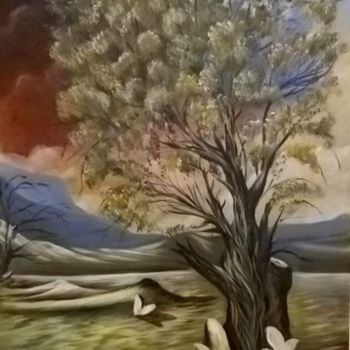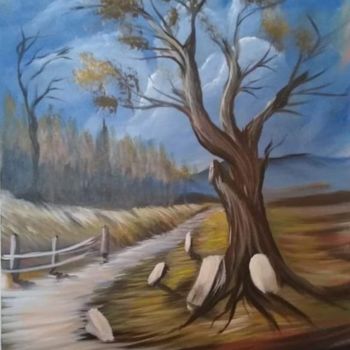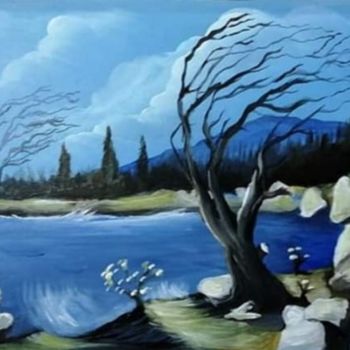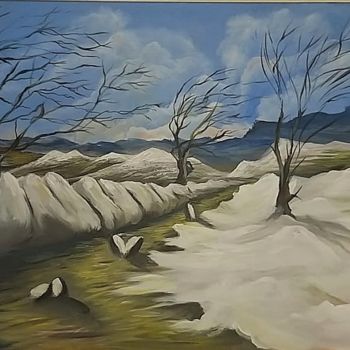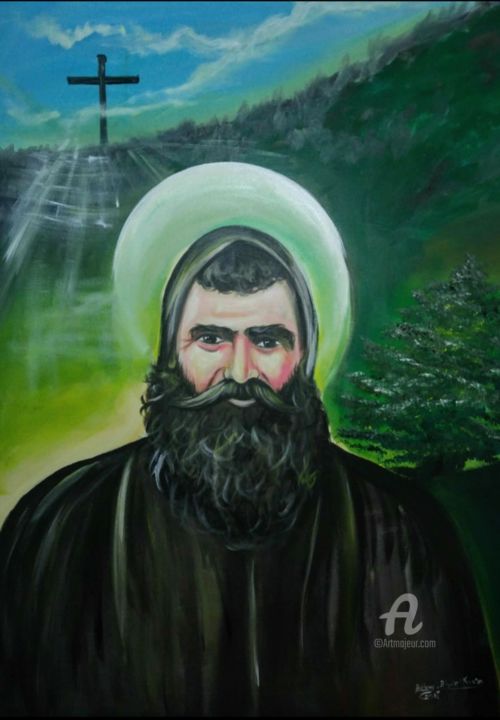


Faites-nous savoir si vous souhaitez voir plus de photos de cette œuvre !
- Arrière de l'oeuvre / Côté de l'oeuvre
- Détails / Signature / Surface ou texture de l'œuvre
- Oeuvre en situation, Autre...
Bienheureux Estephan Nehme (الطوباوي الاخ إسطفان نعمه) (2018) Peinture par Anthony Abdel Karim
Vendu par Anthony Abdel Karim
Cette impression est disponible en plusieurs tailles.
Vendu par Anthony Abdel Karim
Cette image est disponible pour téléchargement avec une licence
Vendu par Anthony Abdel Karim
-
Œuvre d'art originale (One Of A Kind)
Peinture,
Acrylique
sur Toile
- Dimensions Hauteur 39,4in, Largeur 31,5in
- Encadrement Cette oeuvre n'est pas encadrée
1-Sa naissance :
Il est né à Lehfed, le 8 mars 1889. Son père, Estephan Bou Haykal Nehmeh et sa mère, Christina El Badawi Khaled, étaient tous les deux réputés pour leurs bonnes mœurs. Le Père Gergès Fadel lui administra le sacrement du baptême en l’église Notre-Dame de Lehfed, le 15 mars 1889. Il reçut le prénom de Youssef.
2- Sa vie :
Sous le regard bienveillant de ses parents, Youssef a grandi. Il était le benjamin d’une famille composée de trois fils et de deux filles. Il était l’élément choyé et l’ange gardien du foyer.
Il fuyait le tumulte et affectionnait l’isolement. Au cours de sa jeunesse, s’il voulait prier, il s’éloignait de la maison afin de ne pas entendre quoi que ce fût qui perturbât sa prière et sa méditation.
Il a appris les rudiments de la lecture, de l’écriture et du catéchisme avec les enfants du village, sous les arbres avoisinant la belle église dédiée à saint Etienne, à Lehfed.
Dès sa naissance, Youssef aima Dieu et sa sainte Mère, la Vierge. S’il venait à prononcer le nom de cette dernière, son cœur se remplissait de joie, surtout lorsqu’il priait le chapelet. Il en récitait les dizaines, lentement, méditant le sens de chacune.
Il était recueilli dans sa prière. Il avait aussi l’habitude de rappeler aux membres de sa famille leur devoir de prier le soir. Cette prière, toute famille libanaise avait l’habitude de la faire. Parmi ses effets : mener les membres de la famille à la maturité spirituelle et faire de leurs foyers un coin de paradis céleste.
Youssef n’aimait ni les assemblées ni les veillées, même chez les parents proches. Il préférait rester à domicile et prier longuement, puis dormir en murmurant : « Dieu me voit, Dieu me voit. O Jésus, ô Marie, ô saint Joseph, assistez-moi, surtout à l’heure de ma mort
On the holy ground of Lebanon, Brother Estephan Nehme saw the light, under the wings of the Maronite Church he grew up and in the care of the Lebanese Order he raised. He was inspired by the spirit of worship and the motivation of Copyright Imageholiness transferring them in his turn to upcoming generations.
1) His birth :
Brother Estephan Nehme was born in Lehfed, on March 8th, 1889. His parents, Estephan Bou Haykal Nehme and Christina Badawi Hanna Khaled were very decent. He was baptized on March 15th, 1889, at Our Lady Church of Lehfed, by Father Gerges Fadel. He was given the name of Youssef.
2) His life :
Youssef grew up in the warmth of his parents. He was the youngest among three boys and two girls. He was pampered by everyone and he brought joy, and he was the angel of the family. He used to run away from noise and prefer loneliness and quiet. When he wanted to pray, he went to a peaceful place where he could meditate and listen to God. He learnt the basics reading and writing as well as Christian teachings principles with the children of the village under the trees near the Church of Saint Estephan. Since his childhood, Youssef loved God and holy Mother Mary. When Her name was mentioned, his heart jumped joyfully especially when he recited the rosary slowly, meditating each word and sentence. He prayed with deep faith and piety. He used to remind his family to start the traditional evening prayer that fermented the members and turn the Christians houses into a paradise corner.
Youssef was not sociable and he was not interested in parties, even among family. On the contrary, he preferred to stay at home and pray late at night. Afterwards, he went to bed and repeated: “God can see me, God can see me. Jesus, Mary and Saint Joseph, help me at the moment of death.”
3) His integration to the Lebanese Maronite Order :
In 1905, when he was 16 year old, Youssef left his parental house heading to the Monastery of Saints Cyprian and Justine in Kfifane in order to become monk. Eight days later, he wore the novices’ cassock and took the name of “Estephanos”.
On August 23rd, 1907, the Superior of the Convent, Father Youassaf Saker from Kfoun, blessed the simple vows of Brother Estephan who wore the novices’ cassock.Copyright Image
Afterwards, B. Estephan spent a 31 year monastic life: twelve years at the Monastery of Our Lady in Mayfouk, ten years at the Monastery of Notre Dame des Secours in Jbeil, three years at the Monastery of Saint Antonios in Houb and around seven months at the Monastery of Kfifane. He also lived in Saint Chalita Monastery in Kettara and the Monastery of Saint Maron in Annaya.
Brother Estephan was a “worker monk”. He worked in the fields and gardens of the monastery. He was responsible for the field. He learnt as well carpentry when he was in Mayfouk. Furthermore, he was good in construction and he was robust and sturdy. Thus, this tough monk spent his life in the fields of the Order.
4) His death :
Brother Estephan has demarcated the borders of the Order’s land when the latter bought it. He was conveyed to reveal the marks after a long conflict. When he achieved his mission and resolved the problem due to his perspicacity, his cleverness as well as his good intention, he went back to the Monastery of Kfifane. He was extremely tired and ill.
In the evening, when he was sitting with the other monks, Brother Charbel Nehmeh, before going to sleep, asked him if he wanted to get his jar filled with water, and he answered: “Do whatever you want”. When B. Charbel was heading towards the room of the said monk to bring the jar, B. Antonios Ramy followed him asking: “Where is water?” When he followed him, they found out that B. Estephan passed away.
Report on his death:
Brother Estephan had a pious life that ended virtuously at the Monastery of Saints Cyprian and Justine, on August 30th, 1938.
Father Antonios Nehme, Superior of Kfifane Monastery, wrote in the register of deceased monks, number 22:
“On Tuesday 30th of August, 1938, at 7 pm, B. Estephan from Lehfed left this ephemeral world at the age of 49. He was a helpful monk and devoted to the interests of the monastery. He was strong and sturdy, peaceful, kind and sober. He worked in the fields and he was skillful in manual labor. He respected his duties as well as his vows and achieved the required mission meticulously.
Few days before his decease, he went to the Monastery of Mayfouk in order to demarcate the lands of the Maronite Order who bought during the war some pieces of land. Last fall, the partners rebelled claiming the possession of the lands’ totality. Thus, the Order was obliged to prove this possession and confirm it. The monks convened then the topographers in order to demarcate the monastery’s borders. It is worth mentioning that the said people have hidden the limits so that they embezzle the returns. The late monk was convened to uncover the limits since he was present in Mayfouk at the moment of sale. At the end, the borders were revealed as consented at the moment of sale. But B. Estephan got a sunstroke which caused him a severe fever that led to an apoplexy that put an end to his life. May he rest in peace!”
This dear monk passed away at the age of 49. He deceased full of holiness and graces. His work in the field as well as his presence in the different convents, were printed by his humanitarian, Christian and monastic spirit. His prints are still alive and still shining until present.
Brother Estephan was buried in the tomb of monks in the monastery of Kfifane. On March 10th, 1951, while monks were burying the late Father Youssef Souraty who spent his sunset in this convent, they found the body of Brother Estephan non decayed. Then, he was moved to a new tomb where he lays today and where visitors seek his intercession or ask the grace of healing.
الطوباوي الاخ إسطفان نعمه اللحفدي
على أرض لبنان المقدَّسة، أبصر الأخ إسطفان نعمه النور، وفي ظلِّ الكنيسة المارونيَّة نشأ، وفي كنف الرهبانيَّة اللبنانيَّة ترعرع آخذًا منها روح العبادة ونفحةً قُدسِيَّة لينقلها بدوره إلى الأجيال الطالعة.
ولد الأخ إسطفان نعمه في بلدة لحفد، في 8 آذار 1889 من والدَين صالحَين هما إسطفان بو هيكل نعمه وخرستينا البدوي حنَّا خالد. قَبِلَ سرَّ العماد في كنيسة السيِّدة في لحفد على يد الخوري جرجس فاضل، في 15 آذار 1889 وأُعطيَ إسم "يوسف". نشأ يوسف في كنف أبوَيه، وكان صغير العائلة المؤلَّفة من ثلاثة صبيان وابنتين، فكان سلوى العائلة وبهجة البيت وملاكَهُ الحارس، يهرب من الضجيج ويرغب في الخلوة والإنفراد، وإذا أراد أن يُصلِّي في حداثته إبتعدَ عن البيت بحيث لا يَسْمَع ما يعكِّرُ عليه صفوَ صلاته وتأمُّلاته. لقد تعلَّم مبادئ القراءة والكتابة، ومبادئ التعليم المسيحيِّ مع أولاد الضيعة تحت الأشجار الموجودة قرب كنيسة مار إسطفان الجميلة. أحبَّ يوسفُ اللهَ وأمَّه العذراء القدِّيسة منذ نشأته. وكان إذا ذكر إسم والدة الإله القدِّيسة، يبتهج من القلب ويمتلكه الطرب، وبالأخصِّ عندما يبدأ بصلاة سبحته التي يتلو أبياتها وحبَّاتها على مهل، متأمِّلاً معانيها. يصلِّي بانتباهٍ وخشوعٍ، ومن عادته أن ينبِّه أهل البيت والعائلة إلى إقامة الصلاة المسائيَّة التي كان يدأب عليها الشعب اللبنانيُّ في كلِّ بيتٍ، هذه الصلاة العائليَّة الخشوعيَّة التي تخمِّر لفيف العائلة تخميرًا روحانيًّا وتجعل بيوت المسيحيِّين زاوية من الفردوس السماويِّ. لم يكن يوسف يحبُّ الاختلاط بالناس ولا السهريَّات، حتَّى عند الأقارب، بل يلازم بيته ويصلِّي ويطيل وقت الصلاة، ثمَّ يرقد وهو يردِّد: "ألله يراني، ألله يراني، يا يسوع ومريم ومار يوسف عينوني وساعدوني عند ساعة مماتي".
عام 1905 وهو إبن 16 عامًا، غادر يوسف نعمه البيت الوالديَّ متوجِّهًا إلى دير مار قبريانوس ويوستينا في كفيفان ليترهَّب فيه. دخل في سلكِ المبتدئين، وبعد ثمانية أيَّام، لبس ثوب الابتداء، واتَّخذ إسم "إسطفانوس". وفي 23 آب 1907، أبرز الأخ إسطفان نذوره الرهبانيَّة، ولبس الإسكيم الملائكيَّ على يد رئيس الدير الأب يواصاف صقر من الكفون. عاش الأخ إسطفان، بعد نذره الرهبانيِّ، إحدى وثلاثين سنة في الرهبانيَّة. قضى منها قرابة الاثنتَي عشرة سنة في دير سيِّدة ميفوق، وقرابة العشر سنوات في دير سيِّدة المعونات في جبيل، وثلاث سنوات في دير مار أنطونيوس حوب، وحوالي ستَّة أو سبعة أشهر في دير كفيفان قبل وفاته. كما عاش أيضًا في دير مار شلِّيطا – القطَّارة، ودير مار مارون – عنَّايا. عاش الأخ إسطفان "أخ عامل" يعمل في جنائن الأديار وبساتينها، فكان رئيس "حقله"، أي خَوليًّا على أملاك الدير. كما أتقن مهنة النجارة التي تعلَّمها أثناء وجوده في دير ميفوق. وبالإضافة إلى النجارة، أتقن مهنة بناء الحجر، وكان معروفًا بِبُنيتِه الجسديَّة القويَّة وقوَّة ساعده… وهكذا، أمضى هذا الراهب سنيَّ حياته يعمل في جنائن الأديار التي تنقَّل فيها. كان الأخ إسطفان يعلم جيَّدًا تخوم الأرض، وقد حدَّدها بدماغات وضعها سابقًا في بعض الأمكنة فقد ساهم في كشف هذه الدماغات لمساعدة الدير على تحديد تخوم أراضيه. وبعد أن تـمَّمَ هذه المهمَّة في دير سيِّدة ميفوق، وحلَّ المشكلة بذكائه الحادِّ وروحه الطيِّبة وضميره الحيِّ، عاد إلى دير كفيفان. وكان متوعِّكًا صحِّيًّا، وبدا عليه التعب الشديد. وفيما كان جالسًا مساءً على المشرقيَّة مع الرهبان، سأله الأخ شربل نعمه إذا كان يُريد أن يملأ له الإبريق ماءً قبل أن ينام، فقال له: "إعمل ما تشاء"، ذهب الأخ شربل إلى غرفة الأخ إسطفان لملء الإبريق، وإذ بالأخ أنطونيوس الرامي يتبعه صارخًا: "أين الماء، أين الإبريق؟"، وأشار عليه أن يتبعه فوجدوا الأخ إسطفان قد فارق الحياة. ختم الأخ إسطفان نعمه حياته بالبرارة في دير ما قبريانوس ويوستينا كفيفان، وذلك في 30 آب 1938. وهذا ما كتب عنه رئيس الدير، الأب أنطونيوس نعمة اللحفديّ، في روزنامة الدير، باب الوفيَّات: "غادر هذه الفانية نهار الثلاثاء الساعة السابعة مساءً في الثلاثين من آب سنة ألف وتسعماية وثمانٍ وثلاثين، سنة 1938 وكان أخًا عاملاً نشيطًا غيورًا على مصلحة الدير، قويَّ البنية، صحيح الجسم، مسالماً بعيدًا عن الخصومات، قنوعًا. وكان يتعاطى الأشغال الخارجيَّة في الحقل، فطناً بالأعمال اليدويَّة، محافظاً على واجباته ونذوراته، قائماً بما عهد إليه أحسن قيام. وقبل وفاته ببضعة أيَّام ذهب الى دير ميفوق بخصوص تحديد الأراضي لأنَّ الرهبنة كانت اشترت من بعض شركاء دير ميفوق بعض أملاك أيَّام الحرب، وكان رحمه الله آنذاك في دير ميفوق، كانت تخصُّهم، وفي الخريف الماضي ثار الشركاء المذكورون على الرهبنة وادَّعوا ملكيَّة كلِّ أراضي الدير، فاضطرَّت الرهبنة إلى إثبات ملكيَّتها وتقريرها فاستدعت لجنة المساحة لمسح أراضي الدير، ولأنَّ البائعين كانوا قد أخفوا التخوم ليختلسوا ما باعوا، دُعي، رحمه الله، إلى هناك ليدلَّهم على التخوم وكان لم يزل يعرفها تماماً فرُفع التراب عنها فبانت كما كان وقع الاتِّفاق عليها حين البيع. فأثَّر فيه الحرُّ فأصابته وعكة صحيَّة بسيطة تلاها دور حمَّى ثمَّ سكتة دماغيَّة، كانت فيها نهاية حياته. رحمه الله". هكذا توفِّي الأخ إسطفان في 30 آب 1938 برائحة القداسة وهو في التاسعة والأربعين من عمره، بعد أن طبع مروره في كلَّ دير، وعمله في كلِّ حقل بروحه الإنسانيَّة والمسيحيَّة والرهبانيَّة الطيِّبة، وبصماتُه لا تزال حيَّة مُشعَّة حتَّى يومِنا. دُفِن الأخ إسطفان في مقبرة الرهبان في دير كفيفان. وفي 10 آذار 1951، بينما كان رهبان الدير يدفنون المرحوم الأب يوسف الصوراتي، الذي قضى شيخوخته في هذا الدير، وجدوا أنَّ جثمان الأخ إسطفان لا يزال سليمًا. عندئذٍ نُقِلَ جُثمانه إلى قبرٍ جديدٍ حيث لا يزال موجودًا حتَّى الآن، يزورُه كلُّ من يلتجئ إليه ويطلب إليه نعمةً ما، أو الحصول على شفاء من مرضٍ ما.
Thèmes connexes
Anthony Abdel Karim est un artiste et auteur libanais né à Beyrouth en 1998. Il est le fondateur du Club libanais des artistes visuels et a été invité en novembre 2022 par l'Oxford Union à s'exprimer sur le mandat de la Saint-Michel.
Il s'inspire principalement des mouvements classiques et réalistes en utilisant ses propres techniques pour peindre des paysages au caractère tourmenté. Son style est réaliste avec une petite touche de surréalisme.
L'un des éléments les plus répétés de son travail est l'arbre nu plié par le vent pendant la tempête.
Expositions privées :" Au Bord du Rêve ", sous le patronage de S.E. Dr. Ghattas Khoury, 2017, Palais Municipal de Sin el Fil."
Un Soupçon de Nature" sous le patronage du Ministère de la Culture en collaboration avec l'association IDRAAC, Palais Municipal de Sin El Fil, 2018.
-
Nationalité:
LIBAN

- Date de naissance : date inconnue
- Domaines artistiques:
- Groupes: Artistes Contemporains Libanais




